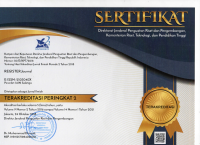THE IDEAL MANUSCRIPT FAVORED BY REGISTER JOURNAL EDITORIAL BOARD
THE IDEAL MANUSCRIPT FOR REGISTER JOURNAL FUTURE ISSUES WILL BE: 1. Show the apparent novelty, research gap, and theoretical contribution of the manuscript 2. The focus and scope of REGISTER JOURNAL: applied linguistics and English teaching, but the implementation of linguistics in English teaching will be most favored. 3. On the part of INTRODUCTION to CONCLUSION should be 4.000 – 5.250 words or at least 17 until 22 pages. See REGISTER JOURNAL Author Guidelines: https://journalregister.iainsalatiga.ac.id/index.php/register/pages/view/justforauthor 4. The similarity score by using Turnitin or iThenticate should be less than 20 %. 5. The minimum requirement of references is between 30-60 references and 40-80 % taken from reputable International journals. 6. Arrange your manuscript following REGISTER JOURNAL author guidelines: https://journalregister.iainsalatiga.ac.id/index.php/register/pages/view/justforauthor and article template in ms words B5 Format: https://drive.google.com/file/d/1D5x7lWBoO0TfgZKTq8YUKr1hCuQpE_HT/view These are the details of REGISTER JOURNAL author guidelines: On the part of ABSTRACT: The abstract should briefly describe your entire paper. It comprises the purposes of the research, method, and study findings from the researcher's perspective. It is advised that researchers refrain from citing the works of others when writing abstracts. Instead, the section gives a researcher 15 seconds to provide a narrative for readers to have a mental picture of the entire research s/he has conducted. On the part of INTRODUCTION: State the objectives of your work and provide an adequate background, avoiding a detailed literature survey or a summary of the results. Explicitly state the gap in the literature, which signifies the significance of your research On the part of RESEARCH METHOD: This section explains the rationale for the application of specific approaches, methods, procedures, or techniques used to identify, select, and analyze information applied to understand the research problem/project, thereby allowing the readers to evaluate your project’s/study's overall validity and reliability critically. On the part of RESULT & DISCUSSION: The discussion is written to interpret and describe the significance of your findings in light of what was already known about the issues being investigated and to explain any new understanding or insights about the problem after you have considered the findings. It should connect to the introduction by way of the research questions or hypotheses you posed and the literature you reviewed, but it does not simply repeat or rearrange the introduction; this section should always explain how your study has moved the reader's understanding of the research problem forward from where you left them at the end of the introduction. The research findings in the form of research data are further discussed or critically interpreted with a particular relevant theoretical approach. Data can also be supported with the presentation of tables, images, etc. Captions for the table is written above it with sequenced numbering so that it can be easily referred to, though not put under the pointing sentence/ paragraph On the part of CONCLUSION: The conclusion is intended to answer the research problems or purposes. It helps the readers understand why your research should matter to them after reading the paper. It is not just a summary of the main topics covered or a re-statement of your research problem, but a synthesis of key points and, if applicable, where you recommend new areas for future research.
Regards, Editor in Chief Faizal Risdianto,S.S,M.Hum register@iainsalatiga.ac.id https://journalregister.iainsalatiga.ac.id/index.php/register/index
|










